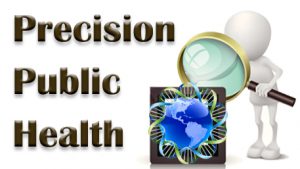Precision Public Health: What Is It?
Posted on by In the past two years the term “precision public health” has been increasingly used in the scientific literature and at professional meetings. A quick PubMed search of the term shows 28 papers (as of April 30, 2018) dating back to our 2016 paper, “Precision Public Health for the Era of Precision Medicine.” The papers cover a wide range of topics from infectious to noninfectious diseases, in developed and developing countries, but focus mostly on the use of technologies (e.g., genomics, spatial analysis, big data) in public health practice. But what exactly is precision public health? And why should the term be used and for what purpose?
In the past two years the term “precision public health” has been increasingly used in the scientific literature and at professional meetings. A quick PubMed search of the term shows 28 papers (as of April 30, 2018) dating back to our 2016 paper, “Precision Public Health for the Era of Precision Medicine.” The papers cover a wide range of topics from infectious to noninfectious diseases, in developed and developing countries, but focus mostly on the use of technologies (e.g., genomics, spatial analysis, big data) in public health practice. But what exactly is precision public health? And why should the term be used and for what purpose?
In their recent editorial in Frontiers in Public Health, Weeramanthri et al discussed the rapidly evolving field of precision public health and its various proposed definitions. As an introduction to several articles published as part of a special research topic, they posed important questions to help clarify the scope of this emerging field. A primary focus of the articles is the use of new precision technologies to improve public health policy and practice. These discussions are an important prelude to a Precision Public Health Asia Symposium that will be held in October 2018 to continue work on a consensus definition of precision public health, to explore ethical and social implications of the field, and to develop further collaboration in the region.
… if precision medicine is about the individual, precision public health is about populations. It is essentially about delivering “the right intervention at the right time, every time to the right population.”
In the midst of this evolution, one can only wonder what is the scope of precision public health and when the term should be used. One way to answer this question is to revisit the concept of “precision medicine”. Between the 2011 National Science Foundation report on precision medicine, and the launch of the 2015 US Precision Medicine Initiative, precision medicine has evolved in its definition and use. More and more, precision medicine is used instead of “personalized medicine,” as we discussed in an earlier blog. Increasingly, precision
medicine has been defined as “an emerging approach for disease treatment and prevention that takes into account individual variability in genes, environment, and lifestyle for each person.” Of course, a main driver of precision medicine is better technology (genomics and various omics to all the ways of measuring environmental factors). But the distinguishing feature of precision medicine is its unit of intervention, which is “each person.” In lay terms, precision medicine can be thought of as giving “the right treatments at the right time, every time to the right person.” Of course, this has always been the goal of medicine, but the tools and technologies from genomics to big data are beginning to be applied—even though there is still a lot of hype about such applications. In other words, there is still quite a bit of imprecision and uncertainty in precision medicine.
In our original paper on precision public health, we provided three examples of the use of technologies to better enhance precision in public health, including the use of pathogen genomics, enhanced surveillance and informatics, and targeted interventions. But ultimately, precision public health is more than just the use of technologies. It is about “populations” as the unit of intervention that use these technologies. The same technologies that fuel precision medicine can also fuel more precision in public health activities. But as the field matures, we should not lose sight of what we are trying to do at the population level, namely to use better and more precise data to target disease prevention and control, and to improve health and health equity worldwide. Using better public health surveillance, laboratory investigations and geospatial modelling may allow more precise targeted population interventions. For example, Dowell et al showed that 90% of the mosquito-related infectious disease burden worldwide (e.g. Dengue, Chikungunya) could be addressed by focusing on just 14% of the high risk geographic areas. Simply put, if precision medicine is about the individual patient in front of us, precision public health is essentially about implementing “the right intervention at the right time, every time to the right population.”
While precision medicine and precision public health can be viewed as next generation medicine and next generation public health, they still have much unfulfilled potential and a long way to go in terms of methodologic applications and success stories. We look forward to the interesting dialogue and discussions before, at, and after the 2018 precision public health Asia symposium and the concrete ideas for collaborative projects that will be developed in the next few years.
Posted on by


